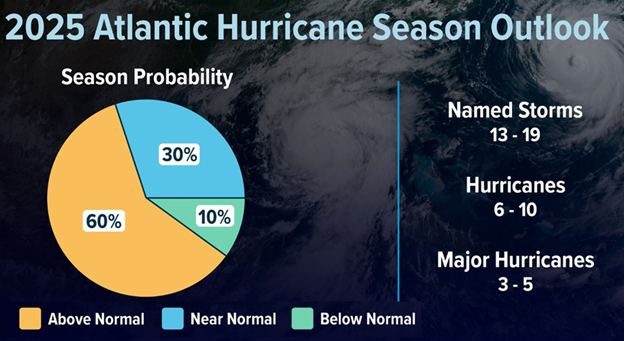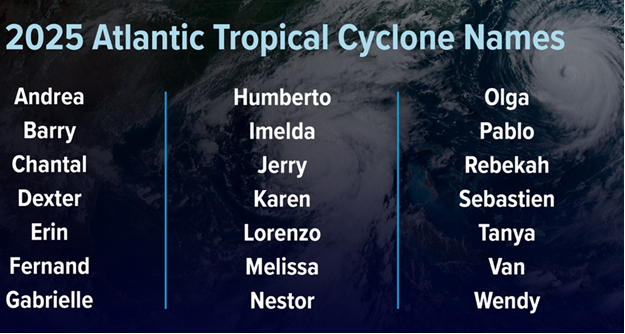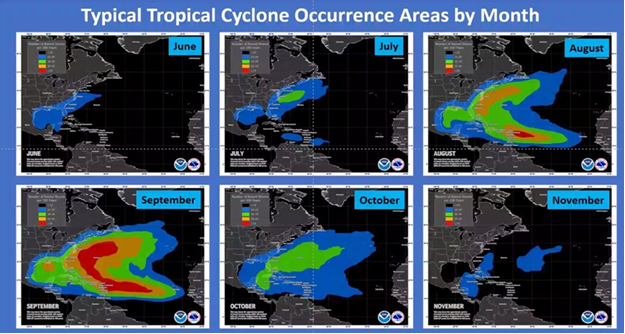Hurricanes

Hurricanes
2024 Recap
2025 Forecast
Differences between Watch and Warning
Hurricane Preparedness Tips
2024 Recap
Atlantic hurricane season runs from June 1st to November 30th, although the risk of hurricanes in Nova Scotia is highest during the months of September and October. Hurricanes are classified by categories ranging from 1 to 5. Regardless of the category a hurricane can cause extensive damage. Wind is responsible for much of the structural damage, as well as the uprooted trees and the downed power lines. Even a significantly weakened hurricane can carry winds strong enough to cause widespread destruction.
The 2024 Atlantic hurricane season was highly active and destructive, ranking as the third most expensive on record. It produced 18 named storms, including 11 hurricanes and 5 major hurricanes. Several of these storms—such as Beryl, Helene, Kirk, Milton, and Rafael—were especially severe, resulting in significant damage and hundreds of fatalities across the Atlantic region. Estimated losses totaled around $130 billion.
In Nova Scotia, no hurricanes made direct landfall, but the province still felt the impact. Several systems brought heavy rain, strong winds, and localized flooding. These conditions led to power outages and prompted preparedness alerts from provincial emergency officials.
2025 Forecast
The 2025 Atlantic hurricane season is expected to be more active than usual. Forecasts predict 13 to 19 named storms, with 6 to 10 of those developing into hurricanes and 3 to 5 becoming major hurricanes, defined by sustained winds over 119 km/h. Warmer sea surface temperatures and other favorable weather conditions are contributing to this outlook. Residents of Nova Scotia are encouraged to take steps now to prepare—review emergency plans, check emergency kits, and stay alert to local weather updates as the season approaches.



Hurricane Preparedness Tips:
Stay Informed:
Monitor weather forecasts for wind advisories or warnings.
Stay updated on changing weather conditions, especially during winter storms.
Secure Outdoor Items:
Secure or bring inside any outdoor furniture, decorations, or objects that could become projectiles in high winds.
Check and secure items such as trash cans, garden tools, and lightweight structures.
Park Away from Trees and Power Lines:
If possible, park your vehicle away from trees and power lines to reduce the risk of falling branches or lines.
Be Cautious on the Roads:
Maintain a firm grip on the steering wheel, especially if driving in open areas where wind gusts can be strong.
Be alert for debris on the road, and avoid driving under overpasses or bridges during high winds.
Avoid High-Profile Vehicles:
If you're driving a high-profile vehicle like a truck or RV, be extra cautious. These vehicles are more susceptible to strong wind gusts.
Stay Indoors:
If possible, stay indoors during periods of high winds, especially during severe winter storms. Avoid going outside unless absolutely necessary, as flying debris can pose a risk.
Prepare for Power Outages:
Charge electronic devices in advance. Have flashlights, batteries, and other emergency supplies on hand in case of power outages.
Secure Windows and Doors:
Close and latch windows and doors securely to prevent damage from strong gusts. If there's a risk of debris, consider putting up storm shutters.
Trim Trees and Branches:
Regularly trim tree branches that could potentially break and cause damage during high winds. Remove dead or weakened trees to minimize the risk of falling.
Stay Away from Windows:
If high winds are accompanied by snow or ice, stay away from windows to avoid injury in case of shattered glass.
Have an Emergency Kit:
Ensure you have an emergency kit that includes essentials like water, non-perishable food, blankets, and a first aid kit.
Stay Updated on Alerts:
Sign up for local weather alerts and emergency notifications to stay informed about changing conditions
If a Tropical Storm/Hurricane WATCH or Tropical Storm/Hurricane WARNING is Issued:
- Fill your bathtub(s) with water for flushing, washing and cleaning
- Be sure to tune in to local broadcast networks for updates from authorities
- Secure all gates, doors and windows
- Move lawn furniture, trash cans, hanging plants or anything that can be picked up by wind
- Trim dead or diseased branches from trees to help make them more wind resistant, or remove dead trees entirely. Safety should always be your first priority when trimming trees. Ensure that you are not working near a power line.
- Park your vehicles in a garage or away from trees
- Fill your car’s gas tank
- Keep pets indoors
- If you own a watercraft be sure it is out of water and up to high ground
FOR THE HOME
- Install storm shutters to all exposed windows and glass surfaces. This is the easiest and most cost-effective way to protect your home from this hazard.
- Garage doors: All garage doors can pose a hazard during a violent wind storm with doors more than eight feet wide being the most vulnerable. Many garage doors can be reinforced at their weakest points by installing wood or metal stiffeners. Some garage doors can be strengthened with retrofit kits.
- Roof: Homes with gable roofs are more likely to suffer damage during a hurricane. A gable roof looks like an "A" on the ends, with the outside wall going to the top of the roof. Check to see if your home has truss roof bracing; if not, be sure to have it installed. If you are replacing your roof, take steps to ensure that both the new roof covering and the sheathing to which it is attached will resist high winds.
- Connections: The points where the roof and the foundation meet the walls of your home are extremely important if your house is to resist high-winds and the pressure they place on the structure.
- Have a professional install hurricane straps – these are designed to help hold your roof to the walls.
- If your home has more than one storey, make certain that the upper storey wall framing is firmly connected to the lower framing.
PERSONAL SAFETY
If you are indoors
- Stay indoors, away from glassed areas.
- Turn on a battery-operated radio and listen for the latest emergency information.
- If told to leave, take your disaster safety kit and go immediately to the designated shelter. Be sure to follow the recommended evacuation routes - never take shortcuts.
- If in a mobile home, get out and seek shelter elsewhere.
- If power is lost, turn down major appliances to reduce power "surge" when electricity is restored.
If you are outdoors
- If possible, get inside a building.
- If there is no shelter, lie down in a ditch or ravine.
- Use your arms to protect your head and neck.
- Stay away from bridges and overpasses.
If you are in a vehicle
- Immediately stop the car and turn off the engine.
- Get out of the vehicle and seek shelter in a building, ditch or ravine. Become familiar with your community's hurricane warning system. Every member of your family should know what to do when a hurricane warning or watch is released. Learn about the disaster safety plans in the workplace and at your home.